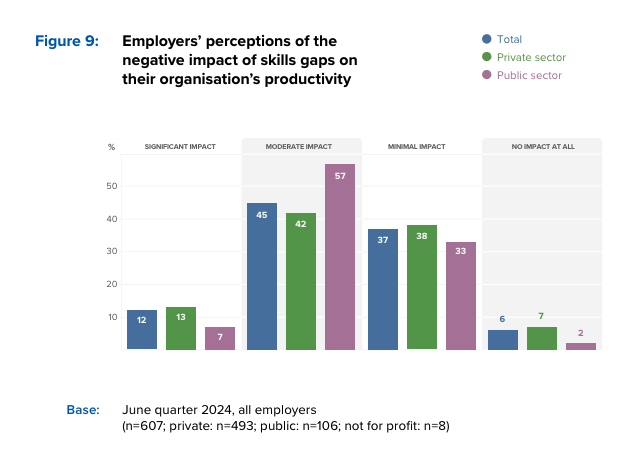AHRI’s latest Quarterly Work Outlook report reveals that Australia’s skills gap is harming productivity, with high turnover predicted to be a key cause.
Amid our nationwide skills shortage, new research from the Australian HR Institute (AHRI) has revealed the scale of this issue at an organisational level.
Employers report almost one in five workers are not proficient in their roles, and a majority (57 per cent) believe skills gaps are having a negative impact on their organisation’s productivity, according to AHRI’s June 2024 Quarterly Australian Work Outlook report.
The report, based on insights from 607 senior HR professionals and decision makers, found that 32 per cent of respondents are experiencing annual turnover of over 20 per cent. This has increased from 25 per cent of respondents in the previous quarter.
This is likely contributing to productivity challenges, due to high vacancy rates and the time needed to train new hires and support them to be fully proficient in their roles.
Skills deficiencies were a greater issue in the public sector, with nearly a quarter (24 per cent) of respondents citing this as a challenge, compared to 18 per cent in the private sector.
“We see these insights as a call to action to invest in skills development as a top priority to avoid sluggish productivity levels having long-term impacts on our economy,” says AHRI’s CEO Sarah McCann-Bartlett. “We will be watching tonight’s budget closely to see how the government plans to help boost skills development in Australia.”
Addressing skills challenges
Despite the worrying headline statistic in this report, it was encouraging to see that 37 per cent of organisations plan to increase training investment in their organisation in the next 12 months, and that only six per cent intend to cut training budgets.
“We saw a significant difference in this intention when cutting the data by sector,” says McCann-Bartlett.
Over half (53 per cent) of public sector employers intend to increase skills investment, compared to just 34 per cent of private sector firms.
“It may be that the public sector has decided this type of investment is necessary to improve productivity. It will be interesting to see the outcomes over time.”

Beyond investing in traditional upskilling and training initiatives, employers can facilitate skills building initiatives through strategies such as:
- Setting up internal secondments, allowing employees to spend a few weeks/months working in a different unit of the business to develop new and transferable skills that they can use in their primary role.
- Facilitating skip-level meetings that allow junior employees to connect with someone two levels above them. The junior employee can shadow the senior and learn what their future progression pathway could look like.
- Setting up reverse mentoring programs where younger employees share knowledge with their more experienced colleagues, as a way to inject diverse perspectives and skills into your organisation.
- Using AI to develop customised learning programs for each employee. AI can assess skills, learning pace and preferences to suggest personalised training modules, optimising learning efficiency and engagement.
This doesn’t even have to be a costly exercise; utilising something like ChatGPT can be a great starting point. Entering the prompt: ‘I am a content coordinator and one day want to be an editor. Write me a career profession plan, including the skills that I will need to develop over the next few years,’ resulted in this relatively comprehensive development plan.
On top of facilitating specific skills-boosting initiatives, employers could also look to streamline recruitment processes.
“Our data underscores the importance of speed to competency as part of the induction and onboarding process to help support productivity, employee engagement and retention,” says McCann-Bartlett.
This could look like introducing new technology or using AI to accelerate recruitment or onboarding efforts.
For example, KPMG – a 2023 AHRI Award finalist – reduced its time to hire by 20 per cent by layering AI into its onboarding process.
Prior to implementing an AI solution, KPMG had 19 disparate recruitment systems and a 47-step onboarding process, and just five per cent of the process was automated. Onboarding took between 89 and 156 days to complete.
“[We had an] opportunity to take stock of a process that had organically grown over decades into something that was really uncontrollable, and wasn’t focused on the candidate,” Rob Dunderdale, Head of Talent Attraction at KPMG Australia told HRM in a previous article.
“Our vision was to deliver talent to the business faster, easier and with purpose.”
Read more about KPMG’s approach to using AI at work here.
McCann-Bartlett stresses the importance of investing in effective line management capability as part of solving this skills challenge.
“This is especially true given that evidence shows that a poor employee-line manager relationship can drive job dissatisfaction. It is well-known that high-quality leadership and management results in higher productivity.”
In fact, research suggests that approximately a third of the world’s productivity gaps could be attributed to poor management, so manager capability uplift should form a key part of lagging organisations’ solutions.
Pay expectations
As well as grappling with a skills shortage, employers are also feeling the pressures of a cost-of-living crisis; businesses are managing a reduction in consumer spending, an increase in operational costs and, in some instances, supply chain challenges.
All of this is impacting employee wages. AHRI’s report found a fall in pay expectations, showing that employers expect mean basic pay increase (excluding bonuses) to be 3.0 per cent in the 12 months to April 2025, down from the 3.7 per cent previously predicted for the 12 months to January 2025.
“Our data underscores the importance of speed to competency as part of the induction and onboarding process to help support productivity, employee engagement and retention.” – Sarah McCann Bartlett, CEO, AHRI
Wage expectations were higher in the public sector (4.5 per cent) than in the private sector (2.6 per cent).
“The findings from this quarter’s outlook align with the Reserve Bank of Australia’s view that while the labour market has eased, it remains tight, with wages growth higher than is sustainable at current levels of productivity growth,” says McCann-Bartlett.
Recruitment and redundancy insights
AHRI has reported strong demand for labour in the June 2024 quarter, with net employment intentions of +36, up from +33 in the March quarter.
However, recruitment difficulties continue to plague employers, with 40 per cent of those who are recruiting reporting trouble doing so (up from 38 per cent last quarter).
Redundancy intentions have remained at similar levels to the previous quarter, currently sitting at 23 per cent for the upcoming quarter.
McCann-Bartlett advised organisations wanting to boost productivity to ask themselves what changes need to be made to retain talented employees and attract the best new talent.
“They may need to consider if their offering is sufficient, and whether they need to offer better pay, increased training or greater flexible working opportunities. Each workplace is unique, which is why a nuanced, considered approach is important.
“AHRI’s findings reflect ongoing tightness in the Australian labour market, despite some modest loosening over the past year. They reinforce the imperative for HR professionals and employers to engage, reward and retain employees, with employee retention remaining a key focus for HR professionals.”
For more detailed insights, download the full AHRI report here.

